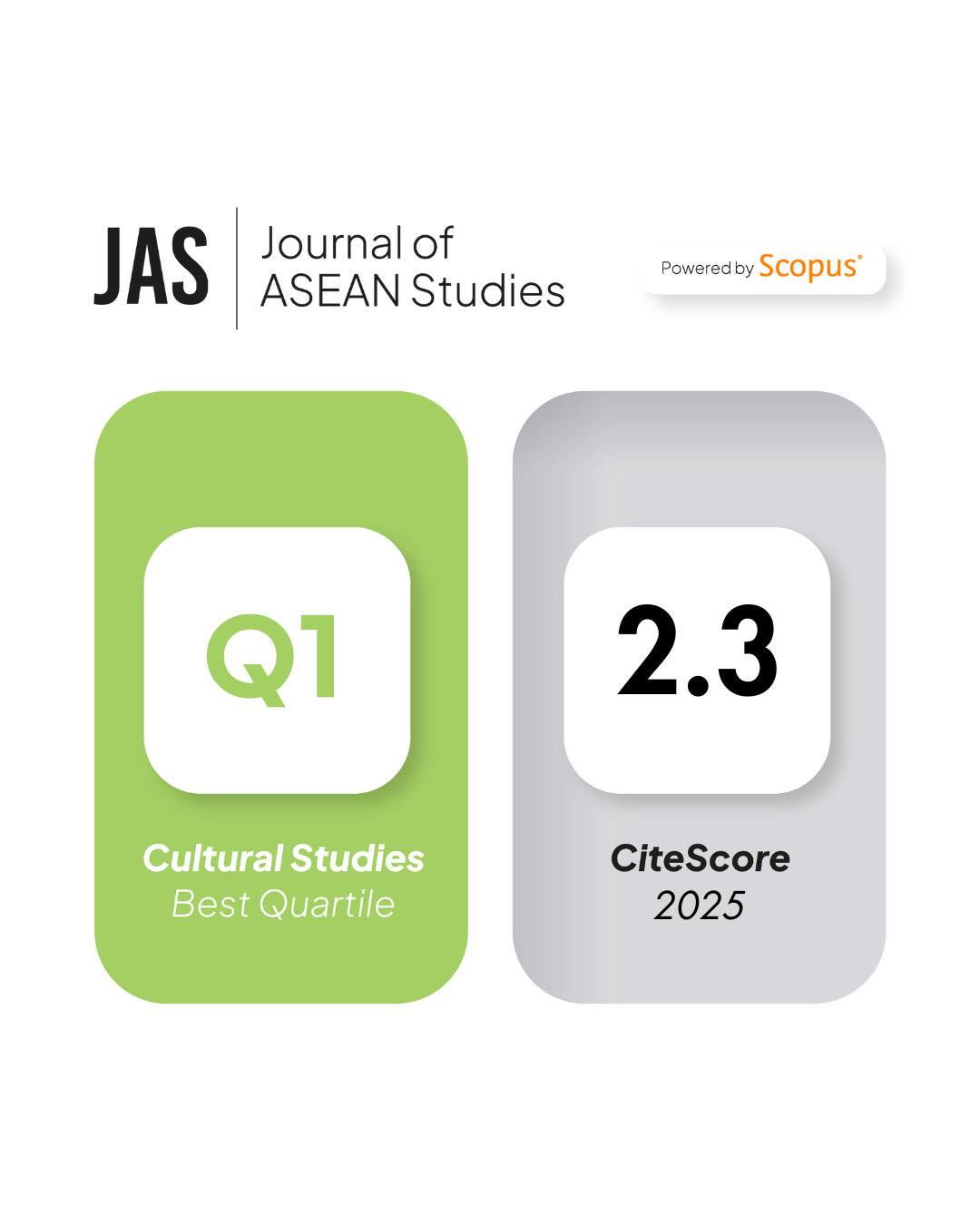The Long-Run Impact of Educational Expansion on Income Inequality in ASEAN Countries
DOI:
https://doi.org/10.21512/jas.v13i1.12204Keywords:
educational expansion, enrollment, mean years of schooling, income inequalityAbstract
Over the past two decades, global income inequality has tended to increase, particularly in developing countries within the ASEAN region. Global, regional, and national efforts to narrow income inequality have been ongoing, as have research endeavours. The correlation between educational expansion and income inequality remains debatable. This research aimed to re-investigate the impact of educational expansion on income inequality across ASEAN countries. The researcher utilized panel data from 11 ASEAN member states for the period 2010 to 2021. Using Panel Fully Modified Least Square (FMOLS) analysis, the research finds that educational expansion, proxied by average years of schooling, significantly contributes to reducing income inequality in the long run. Additionally, the gross enrollment rates in secondary and higher education were found to have a strong effect on narrowing income inequality among the populations of ASEAN countries in the long term, in contrast to the impact of gross enrollment rates in primary education. These findings further reinforce the theory and previous research that education is a key factor in reducing income inequality. Therefore, governments in each country should focus on accelerating the expansion and development of secondary and higher education.
References
Adjor, D. M., & Kebalo, L. (2018). Does corruption matter for unemployment in SADC countries? Review of Economic and Business Studies, 11(2), 65–92. https://doi.org/10.1515/rebs-2018-0074
Akita, T., Celeste, R., & Miyata, S. (2023). Why has inequality in the Philippines declined? A two-stage hierarchical inequality decomposition analysis by location and education. Journal of the Asia Pacific Economy, Latest Art, 1–20. https://doi.org/10.1080/13547860.2023.2220262
Akita, T., & Miyata, S. (2021). Urban and Rural Dimensions of the Role of Education in Inequality: A Comparative Analysis Between Indonesia, Myanmar, and the Philippines. In A. A. Batabyal, Y. Higano, & P. Nijkamp (Eds.), Rural–Urban Dichotomies and Spatial Development in Asia (pp. 127–166). Springer Singapore. https://doi.org/10.1007/978-981-16-1232-9_6
Akita, T., & Miyata, S. (2024). Education and Expenditure Inequality in Indonesia and the Philippines: A Comparative Analysis in an Urban and Rural Dual Framework. In B. P. Resosudarmo & Y. Mansury (Eds.), The Indonesian Economy and the Surrounding Regions in the 21st Century: Essays in Honor of Iwan Jaya Azis (pp. 191–218). Springer Nature Singapore. https://doi.org/10.1007/978-981-97-0122-3_10
Alawin, M., & Sbitany, N. (2019). Gender inequality and economic development in the MENA region. Applied Econometrics and International Development, 19(1), 81–94. https://www.usc.es/economet/reviews/aeid1916.pdf
Alesina, A., & Perotti, R. (1996). Income distribution, political instability, and investment. European Economic Review, 40(6), 1203–1228. https://doi.org/10.1016/0014-2921(95)00030-5
Ali, W., Ambiya, & Dash, D. P. (2023). Examining the perspectives of gender development and inequality: A tale of selected Asian economies. Administrative Sciences, 13, 115. https://doi.org/10.3390/admsci13040115
Arshed, N., Anwar, A., Hassan, M. S., & Bukhari, S. (2019). Education stock and its implication for income inequality: The case of Asian economies. Review of Development Economics, 23(2), 1050–1066. https://doi.org/10.1111/rode.12585
Arshed, N., Anwar, A., Kousar, N., & Bukhari, S. (2018). Education enrollment level and income inequality: A case of SAARC economies. Social Indicators Research, 140(3), 1211–1224. https://doi.org/10.1007/s11205-017-1824-9
Ashraf, A., Batool, S. A., & Jasinska, E. (2023). FDI and women empowerment in developing countries: does the entry heterogeneity matter? Applied Economics Letters, Latest art, 1–5. https://doi.org/10.1080/13504851.2023.2275659
Batuo, M. E., Kararach, G., & Malki, I. (2022). The dynamics of income inequality in Africa: An empirical investigation on the role of macroeconomic and institutional forces. World Development, 157, 105939. https://doi.org/https://doi.org/10.1016/j.worlddev.2022.105939
Becker, G. S. (1964). Human Capital: A Theoretical and Empirical Analysis with Special Reference to Education (1st ed.). NBER.
Bicaba, Z., Brixiová, Z., & Ncube, M. (2017). Can extreme poverty in Sub-Saharan Africa be eliminated by 2030? Journal of African Development, 19(2), 93–110. https://doi.org/10.5325/jafrideve.19.2.0093
Bourguignon, F. (2004). The Poverty-Growth-Inequality Triangle (pp. 1–33). Indian Council for Research on International Economic Relations.
Cappelli, F., Costantini, V., & Consoli, D. (2021). The trap of climate change-induced “natural†disasters and inequality. Global Environmental Change, 70, 102329. https://doi.org/10.1016/j.gloenvcha.2021.102329
Chancel, L., Piketty, T., Saez, E., & Zucman, G. (2022). World Inequality Report 2022. https://wir2022.wid.world/www-site/uploads/2022/03/0098-21_WIL_RIM_EXECUTIVE_SUMMARY.pdf
Checchi, D. (2001). Education, inequality and income inequality (52; Discussion Paper). https://sticerd.lse.ac.uk/dps/darp/DARP52.pdf
Chen, G., & Zhang, J. (2023). Regional inequality in ASEAN Countries: Evidence from an outer space perspective. Emerging Markets Finance and Trade, 59(3), 722–736. https://doi.org/10.1080/1540496X.2022.2119810
Chiswick, B. R. (1974). The Schooling Model. In B. R. Chiswick (Ed.), Income Inequality: Regional Analyses within a Human Capital Framework. NBER. https://www.nber.org/system/files/chapters/c3671/c3671.pdf
Choi, I. (2001). Unit root tests for panel data. Journal of International Money and Finance, 20(2), 249–272. https://doi.org/10.1016/S0261-5606(00)00048-6
Coady, D., & Dizioli, A. (2018). Income inequality and education revisited: persistence, endogeneity and heterogeneity. Applied Economics, 50(25), 2747–2761. https://doi.org/10.1080/00036846.2017.1406659
Desai, S., & Kulkarni, V. (2008). Changing Educational Inequalities in India in the Context of Affirmative Action. Demography, 45(2), 245–270. https://doi.org/10.1353/dem.0.0001
Ghosh, S., Doğan, B., Can, M., Shah, M. I., & Apergis, N. (2023). Does economic structure matter for income inequality? Quality & Quantity, 57(3), 2507–2527. https://doi.org/10.1007/s11135-022-01462-1
Gini, C. (1912). Variabilità e Mutabilità : Contributo Allo Studio Delle Distribuzioni e Delle Relazioni Statistiche. Tipogr. di P. Cuppini.
Hendel, I., Shapiro, J., & Willen, P. (2005). Educational opportunity and income inequality. Journal of Public Economics, 89(5–6), 841–870. https://doi.org/10.1016/j.jpubeco.2004.11.004
Ho, C. M., Le, Q. T.-T., Vo, A. T., Vo, D. H., & Ha, D. T.-T. (2020). Does government spending on education affect provincial income in equality in Vietnam? The Singapore Economic Review, 66(04), 1105–1123. https://doi.org/10.1142/S0217590820490065
Ismail, R. (2000). Educational and Income Inequality in Malaysia. Humanomics, 16(2), 19–40. https://doi.org/10.1108/eb018851
Kao, C. (1999). Spurious regression and residual-based tests for cointegration in panel data. Journal of Econometrics, 90(1), 1–44. https://doi.org/10.1016/S0304-4076(98)00023-2
Kebalo, L., & Zouri, S. (2024). Income inequality in developing countries: fiscal policy’s role amid uncertainty. Journal of Applied Economics, 27(1), 2316969. https://doi.org/10.1080/15140326.2024.2316969
Khusaini, K., Sentosa, B. M., & Putro, T. R. (2023). Fiscal transfer policies and road infrastructure reduce income inequality in rural-urban areas. Etikonomi, 22(2), 333–356. https://doi.org/10.15408/etk.v22i2.28618 Fiscal
Koh, S. G. M., Lee, G. H. Y., & Siah, A. K. L. (2022). The resurgence of income inequality in Asia-Pacific: The role of trade openness, educational attainment and institutional quality. Jurnal Ekonomi Malaysia, 56(3), 11–27. https://doi.org/10.17576/JEM-2022-5603-01
Kuznets, S. (1963). Quantitative aspects of the economic growth of Nations: VIII. Distribution of Income by Size. Economic Development and Cultural Change, 11(2, Part 2), 1–80. https://doi.org/10.1086/450006
Lee, J. W., & Lee, H. (2018). Human capital and income inequality*. Journal of the Asia Pacific Economy, 23(4), 554–583. https://doi.org/10.1080/13547860.2018.1515002
Lee, K. K., & Vu, T. V. (2020). Economic complexity, human capital and income inequality: a cross-country analysis. Japanese Economic Review, 71(4), 695–718. https://doi.org/10.1007/s42973-019-00026-7
Levin, A., Lin, C.-F., & James Chu, C.-S. (2002). Unit root tests in panel data: Asymptotic and finite-sample properties. Journal of Econometrics, 108(1), 1–24. https://doi.org/10.1016/S0304-4076(01)00098-7
Lui, H.-K. (2021). Education and Income Inequality in Hong Kong. In Oxford Research Encyclopedia of Education (pp. 1–8). Oxford University Press. https://doi.org/10.1093/acrefore/9780190264093.013.62
Makhlouf, Y. (2023). Trends in income inequality: Evidence from developing and developed countries. In Social Indicators Research (Vol. 165, Issue 1). Springer Netherlands. https://doi.org/10.1007/s11205-022-03010-8
Makhlouf, Y., & Lalley, C. (2023). Education expansion, income inequality and structural transformation: Evidence from OECD countries. Social Indicators Research, 169(1–2), 255–281. https://doi.org/10.1007/s11205-023-03161-2
Marin, A., & Psacharopoulos, G. (1976). Schooling and income distribution. The Review of Economics and Statistics, 58(3), 332–338. https://doi.org/10.2307/1924955
McGregor, T., Smith, B., & Wills, S. (2019). Measuring inequality. Oxford Review of Economic Policy, 35(3), 368–395. https://doi.org/10.1093/oxrep/grz015
Medgyesi, M. (2014). Components of income inequality and its change in EU countries, 2004-2010. In ImPRovE Discussion Paper (14/01; ImPRovE Discussion Paper, Issue 14/01). http://improve-research.eu
Mercado, R., Zhuang, J., & Park, C.-Y. (2023). Trends and drivers of income inequality in the Philippines, Thailand, and Viet Nam: A decomposition analysis (692; ADB Economics Working Paper Series Trends). https://doi.org/10.22617/WPS230301-2
Mijs, J. J. B. (2021). The paradox of inequality: income inequality and belief in meritocracy go hand in hand. Socio-Economic Review, 19(1), 7–35. https://doi.org/10.1093/ser/mwy051
Mincer, J. A. (1958). Investment in Human Capital and Personal Income Distribution. Journal of Political Economy, 66(4), 281–302. http://www.jstor.org/stable/1827422
Mincer, J. A. (1974). Schooling, Experience, and Earnings: Vol. I. NBER. https://www.nber.org/books-and-chapters/schooling-experience-and-earnings
Mohd, S., Hamat, A. F. C., Idris, M., & Kasim, N. H. (2014). Poverty, Education and Income Inequality in Malaysia: Evidence from the 2009 Household Income Expenditure Survey. In H. H. Lean, E. S. Lim, S. L. Khoo, & S. Mohd (Eds.), Proceedings of International Conference on Contemporary Economic Issues 2014: Stimulating Economic Growth, Improving Quality of Life & Enhancing Youth Involvement (pp. 111–118). School of Social Sciences, USM. https://soc.usm.my/index.php/research/publications/262-stimulating-economic-growth-improving-quality-of-life-enhancing-youth-involvement
Munir, K., & Kanwal, A. (2020). Impact of educational and gender inequality on income and income inequality in South Asian countries. International Journal of Social Economics, 47(8), 1043–1062. https://doi.org/10.1108/IJSE-04-2020-0226
Muszyńska, J., & Wędrowska, E. (2023). Does education affect income inequality? A comparative review of fourteen European countries. Economy of Regions, 19(2), 397–409. https://doi.org/10.17059/ekon.reg.2023-2-8
Ngoc, B. H., & Hai, L. M. (2024). Time-frequency nexus between tourism development, economic growth, human capital, and income inequality in Singapore. Applied Economics Letters, 31(4), 259–264. https://doi.org/10.1080/13504851.2022.2130865
Nizar, N. I., Nuryartono, N., Juanda, B., & Fauzi, A. (2023). Can knowledge and culture eradicate poverty and reduce income inequality? The evidence from Indonesia. Journal of the Knowledge Economy, 6425–6450. https://doi.org/10.1007/s13132-023-01398-3
Paweenawat, S. W., & Liao, L. (2023). Educational assortative mating and income inequality in Thailand. Journal of Demographic Economics, 89(2), 283–298. https://doi.org/10.1017/dem.2022.9
Pedroni, P. (2000). Fully Modified OLS for Heterogeneous Cointegrated Panels. In Advances in Econometrics (Vol. 15). https://doi.org/10.1016/S0731-9053(00)15004-2
Pedroni, P. (2004). Panel cointegration: Asymtptotic and finite sample properties of pooled time series test with an application to the hypothesis. Econometric Theory, 20(3), 597–625. https://doi.org/10.1017/S0266466604203073
Pesaran, M. H. (2004). General diagnostic tets for cross section dependence in panels (1240; Discussion Paper). https://docs.iza.org/dp1240.pdf
Pesaran, M. H. (2007). A simple panel unit root test in the presence of cross-section dependence. Journal of Applied Econometrics, 22(2), 265–312. https://doi.org/10.1002/jae.951
Pesaran, M. H. (2015). Testing weak cross-sectional dependence in large panels. Econometric Reviews, 34(6–10), 1089–1117. https://doi.org/10.1080/07474938.2014.956623
Pesaran, M. H., & Shin, Y. (1999). An Autoregressive Distributed-Lag Modelling Approach to Cointegration Analysis. In S. Strøm (Ed.), Econometrics and Economic Theory in the 20th Century: The Ragnar Frisch Centennial Symposium (pp. 371–413). Cambridge University Press. https://doi.org/10.1017/CCOL521633230.011
Pesaran, M. H., Shin, Y., & Smith, R. P. (1999). Pooled mean group estimation of dynamic heterogeneous panels. Journal of the American Statistical Association, 94(446), 621–634. https://doi.org/10.1080/01621459.1999.10474156
Pesaran, M. H., & Yamagata, T. (2008). Testing slope homogeneity in large panels. Journal of Econometrics, 142(1), 50–93. https://doi.org/10.1016/j.jeconom.2007.05.010
Pham, T. T., Lang, N. D., Ho, C. M., & Vo, D. H. (2024). Educational attainment, household income and wealth accumulation in Vietnam. In Social Indicators Research (Vol. 172, Issue 2). Springer Netherlands. https://doi.org/10.1007/s11205-024-03321-y
Ridzuan, A. R., Zakaria, S., Fianto, B. A., Yusma, N., Yusoff, M., Fatimah, N., Sulaiman, C., Razak, M. I., & Lestari, A. (2021). Nexus between financial development and income inequality before pandemic covid-19 : Does financial Kuznets curve exist in Malaysia, Indonesia, Thailand and Philippines? International Journal of Energy Economics and Policy, 11(2), 260–271. https://www.econjournals.com.tr/index.php/ijeep/article/view/10616
RodrÃguez-Pose, A., & Tselios, V. (2009). Education and income inequality in the regions of the European Union. Journal of Regional Science, 49(3), 411–437. https://doi.org/10.1111/j.1467-9787.2008.00602.x
Schultz, T. W. (1961). Investment in human capital. The American Economic Review, 51(1), 1–17. https://www.jstor.org/stable/1818907
Scripcar, M., & Ciobanu, R. (2021). Can income inequality be reduced through economic development and education? An EU-27 panel analysis. Cross-Cultural Management Journal, XXIII(2), 157–169. https://seaopenresearch.eu/Journals/articles/CMJ2021_I2_3.pdf
Setyadharma, A., Oktavilia, S., Utami, S., & Noormalitasari, A. R. (2021). Impacts of education and environmental sustainability on rural income inequality in Indonesia. In P. Juwaidah, M. M. T. Saiyut, & Z. Rozaki (Eds.), International Conference on Agribusiness and Rural Development (IConARD 2020) (Vol. 232, Issue 04003, pp. 1–12). EDP Sciences. https://doi.org/10.1051/e3sconf/202123204003
Shukla, V., & Mishra, U. S. (2020). Expansion in Education and Its Impact on Income Inequality: Cross-sectional Evidence from India. Indian Journal of Labour Economics, 63(2), 331–362. https://doi.org/10.1007/s41027-020-00221-w
Siburian, M. E. (2023). The impact of education on inequality in a decentralized Indonesia. Journal of the Asia Pacific Economy, Latest Art, 1–12. https://doi.org/10.1080/13547860.2023.2229653
Stiglitz, J. E., Fitoussi, J.-P., & Durand, M. (2018). Beyond GDP. OECD. https://doi.org/10.1787/9789264307292-en
Sulaiman, N. F. C., Yussof, I., Zaidi, M. A. S., & Sulaiman, N. (2017). Long run relationship between income inequality and economic growth: Evidence from Malaysia. International Journal of Academic Research in Business and Social Sciences, 7(6), 73–88. https://doi.org/10.6007/ijarbss/v7-i6/2945
Taresh, A. A., Sari, D. W., & Purwono, R. (2021). Analysis of the relationship between income inequality and social variables: Evidence from Indonesia. Economics and Sociology, 14(1), 103–119. https://doi.org/10.14254/2071-789X.2021/14-1/7
Tey, N. P., Lai, S. L., Ng, S. T., Goh, K. L., & Osman, A. F. (2019). Income inequality across states in Malaysia. Planning Malaysia, 17(2), 12–26. https://doi.org/10.21837/PM.V17I10.625
Thein, A. T. Z., & Akita, T. (2019). Education and expenditure inequality in Myanmar: An analysis with the 2006 and 2012 Household Income and Expenditure Survey in an urban and rural setting. Regional Science Policy & Practice, 11(1), 55–70. https://doi.org/10.1111/rsp3.12188
Thye, G. L., Law, S. H., & Trinugroho, I. (2022). Human capital development and income inequality in Indonesia: Evidence from a nonlinear autoregressive distributed lag (NARDL) analysis. Cogent Economics and Finance, 10(1). https://doi.org/10.1080/23322039.2022.2129372
UNESCO Institute for Statistics. (2012). The International Standard Classification of Education (ISCED) 2011 (pp. 283–284). UNESCO Institute for Statistics. https://uis.unesco.org/sites/default/files/documents/international-standard-classification-of-education-isced-2011-en.pdf
United Nations Development Programme. (2022). Reducing Inequality in the Decade of Action To Achieve the SDGs and Accelerate Post- Pandemic Recovery (pp. 1–47). UNDP Bangkok Regional. https://asean.org/wp-content/uploads/2022/08/FINAL-Policy-Brief-on-Reducing-Inequality.pdf
United Nations Economic and Social Commission for Asia and the Pacific. (2021). Asia and the Pacific SDG Progres Report 2021. https://asean.org/wp-content/uploads/2022/08/FINAL-Policy-Brief-on-Reducing-Inequality.pdf
Vo, D. H., & Ho, C. M. (2022). Does educational attainment and gender inequalities affect wealth accumulation? Evidence from Vietnam. Heliyon, 8(12), e12502. https://doi.org/10.1016/j.heliyon.2022.e12502
Vo, D. H., Vo, A. T., & Ho, C. M. (2024). The short- and long-run effect of human capital on income inequality: Empirical evidence in the ASEAN region. PLoS ONE, 19(7), e0304678. https://doi.org/10.1371/journal.pone.0304678
Vu, H. V. (2020). The impact of education on household income in rural Vietnam. International Journal of Financial Studies, 8(1). https://doi.org/10.3390/ijfs8010011
Widjaya, E. P. O. (2016). Income inequality in Singapore by Pundarik Mukhopadhaya (review). Journal of Southeast Asian Economies, 33(3), 421–422. https://muse.jhu.edu/article/647400
Win, N. W., Oo, Z., Glutting, J. R., Htun, A., & Kanayde, S. (2023). Inequality in Myanmar: Structural Change, Policy Outcomes and Gender Dimensions. In H. A. Lee & C. Choong (Eds.), Inequality and Exclusion in Southeast Asia: Old Fractures, New Frontiers (pp. 133–168). ISEAS–Yusof Ishak Institute. https://www.cambridge.org/core/product/BE080CC48F280557B003E7770CAE7D6D
World Bank. (2023). 2023 in Nine Charts: A Growing Inequality. News. https://www.worldbank.org/en/news/feature/2023/12/18/2023-in-nine-charts-a-growing-inequality.print
Xu, M., Chen, S., Chen, J., & Id, T. Z. (2023). Non-linear links between human capital, educational inequality and income inequality, evidence from China. PLoS ONE, 18(8), e0288966. https://doi.org/10.1371/journal.pone.0288966
Yee, K. M. R. (2024). At all costs: educational expansion and persistent inequality in the Philippines. Higher Education, 87(6), 1809–1827. https://doi.org/10.1007/s10734-023-01092-y
Zhuang, J. (2023). Income and wealth inequality in Asia and the Pacific: Trends, causes, and policy remedies. Asian Economic Policy Review, 18(1), 15–41. https://doi.org/10.1111/aepr.12399
Downloads
Published
How to Cite
Issue
Section
License
Copyright (c) 2025 Khusaini Khusaini, Tetuko Rawidyo Putro, Samsul Arifin, Muhammad Hartana Iswandi Putra, Fitri Amalia, Lely Syafawi

This work is licensed under a Creative Commons Attribution-NonCommercial 4.0 International License.






















